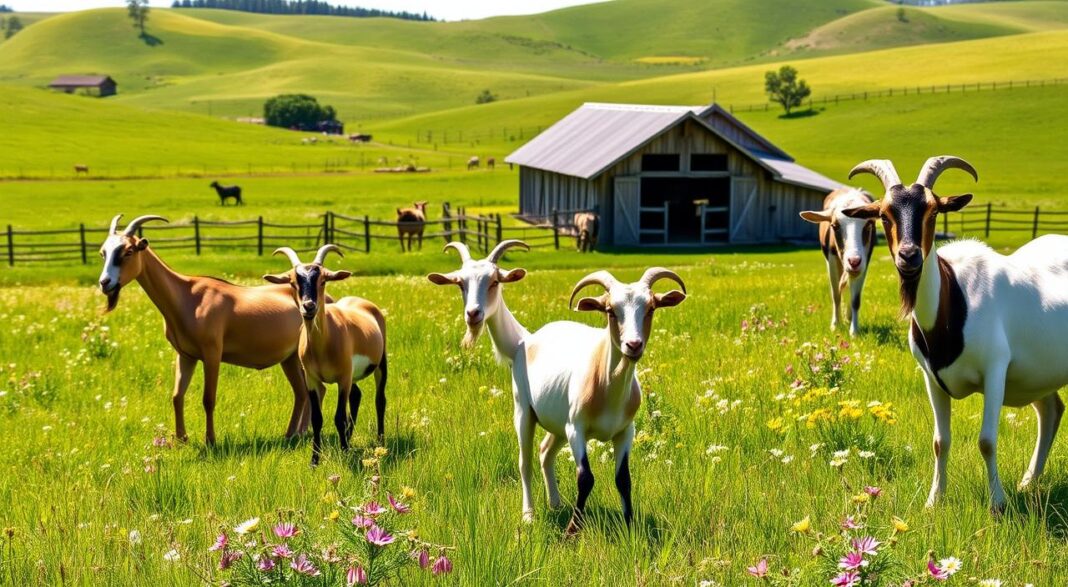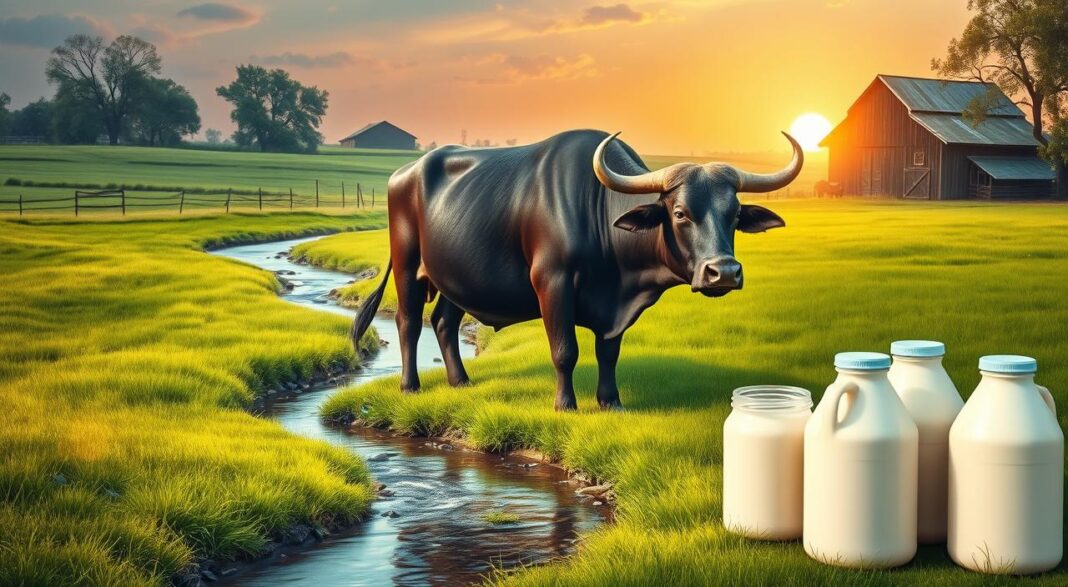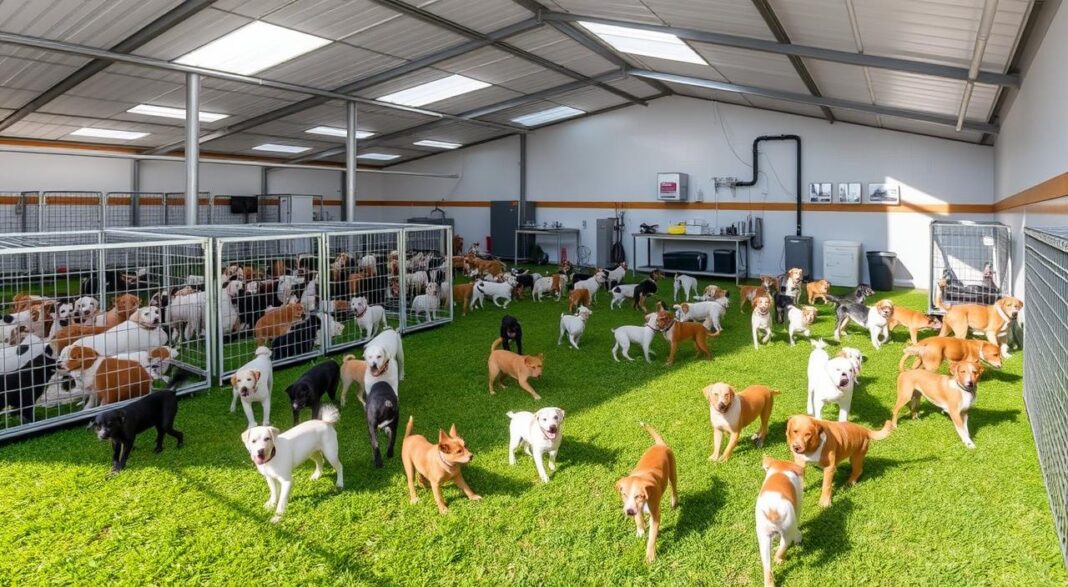Best Goat Breeds for Farming
Goat farming is a key part of India’s history and economy. It helps many farmers earn a living. Goats are raised for their meat, milk, and manure.
Recently, more commercial goat farms have popped up in India. This is because people want more goat meat. The Indian Council of Agricultural Research (ICAR) has created better goat breeds.
These breeds, like Jamunapari, Beetal, and Osmanabadi, produce more milk and meat. They also fight off diseases better and adapt well to India’s climate. The government is helping farmers by giving them money and training.
Key Points
- Goat farming is a lucrative and sustainable livelihood option in India.
- Improved goat breeds developed by ICAR have higher milk and meat yield, disease resistance, and climate adaptability.
- Government initiatives provide financial support and training to promote goat farming in the country.
- Innovative solutions like monitoring systems and digital marketplaces are transforming the goat farming industry.
- Breeds like Jamunapari, Beetal, and Osmanabadi are among the top choices for dairy and meat production.
The Rise of Goat Farming in India
Goat farming in India has seen a big increase in recent years. It’s a profitable business that needs little money and effort to start. The country is a top goat meat producer, making about 4 million tons each year. Goat meat sales in India are also growing fast, at 6% every year.
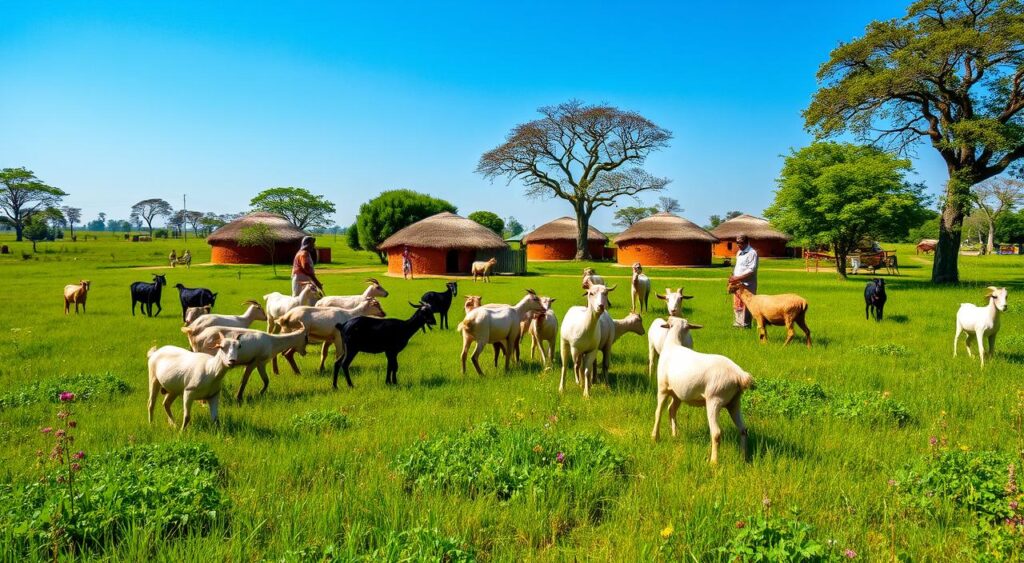
The number of commercial goat farms in India is growing steadily. These farms are found in areas near cities and are run by entrepreneurs who use modern farming methods. The government is also helping by providing money and training for goat farming in India.
- India has 37 registered goat breeds, each with special traits and uses.
- The key goat breeds in India include Jamunapari, Beetal, Barbari, Malabari, Osmanabadi, Changthangi, Surti, Sangamneri, Bengal, and Sirohi, among others.
- These breeds have different milk yields, weights, and other features, meeting various farming and commercial needs.
The growth of goat farming in India is due to its benefits, like needing less money and being more profitable than other livestock farming. With more people wanting goat products, the future of this industry looks bright. Both small and big commercial goat farms are important in meeting India’s changing needs.
Milk Production
Jamunapari Goat Breed
The Jamunapari goat is a highly valued breed from the Etawah district of Uttar Pradesh, India. They are famous for their unique looks and high milk production.
Physical Characteristics
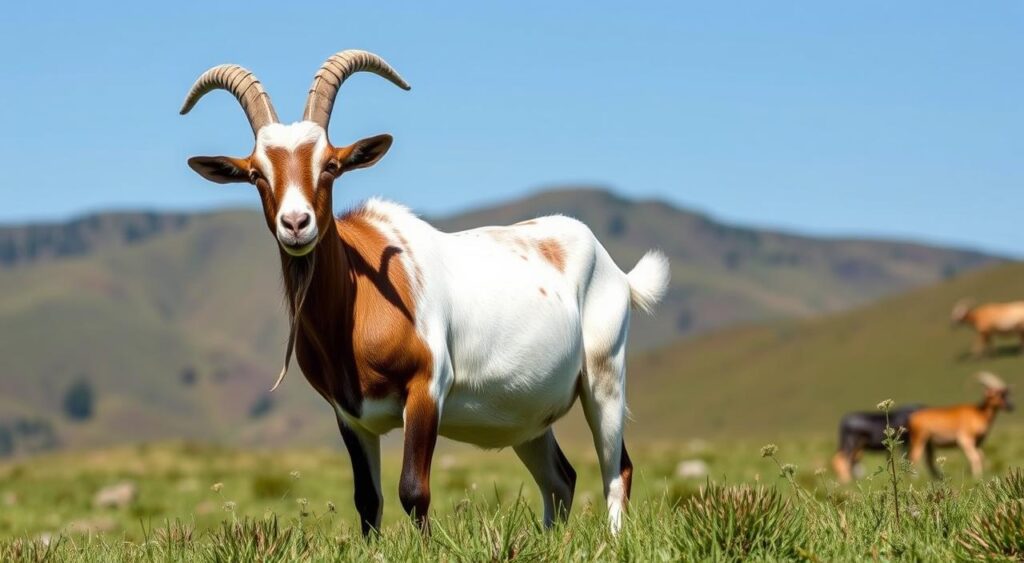
Jamunapari goats are big and tall, with long legs and a white coat. They often have black or tan spots on their necks and ears. Their large ears and curved face make them easy to spot.
Male Jamunapari goats can weigh up to 86 kg. Female goats usually weigh between 45 to 61 kg.
Jamunapari goats are known for their high milk production. They can produce about 2.25 to 2.7 kg of milk daily. Their milk has a rich fat content of around 3.5 percent.
This breed is adaptable, resilient, and valuable for farmers. Its impressive physical traits and milk production make it a key player in India’s goat farming industry.
Beetal Goat Breed
The Beetal goat breed is from the Punjab region of India. They are known for being adaptable, medium to large in size, and great milk producers. This makes them popular among farmers and those who love animals.
Beetal goats are easy to spot because of their black, tan, or reddish-brown coats. They also have long, hanging ears. Adult does weigh 35-60 kg, and bucks weigh 57-100 kg. This shows they are sturdy animals.
These goats are famous for their milk. Does can produce 1-2 liters of milk daily. Their milk is rich in butterfat, which is great for dairy farmers. They also breed well, with an average of 1.66 kids per litter.
Beetal goats can handle many climates. They do well in temperatures from 2°C to 42°C. This makes them perfect for different environments.
Beetal goats are good for both meat and milk. They are strong against common goat diseases. They are also friendly and social, making them great for small and big farms.
In summary, the Beetal goat breed is a smart choice for goat farming in India and nearby areas. They are versatile and can bring in good profits.
Barbari Goat Breed
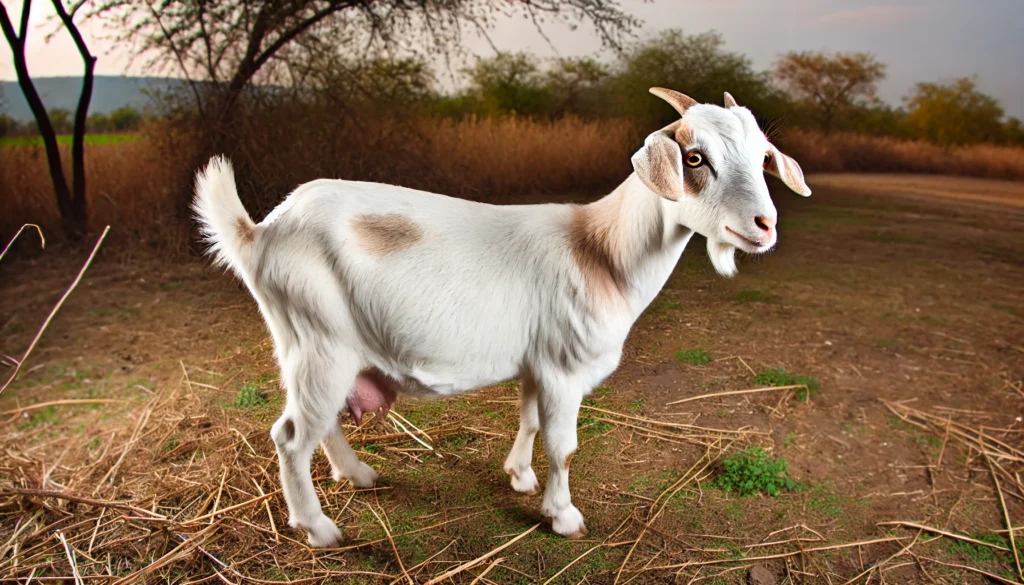
The Barbari goat breed is a true gem in Indian goat farming. They come from the northern parts of India. These goats are hardy and adaptable, making them a versatile breed.
Prolific Breeding
One of the Barbari goat’s standout features is its prolific breeding. They can give birth twice in 12-15 months. This makes them very efficient and productive for farmers.
A Barbari doe can produce 1 to 1.5 kg of milk per day. This adds to their value as a dual-purpose breed.
Barbari goats are mainly found in Haryana, Punjab, and Uttar Pradesh in India. They are also in Punjab and Sindh provinces of Pakistan. With a global population of around 3.4 million in 2024, they are a valuable asset for small-scale farmers.
Barbari goats are known for their physical characteristics. Male goats weigh about 38 kg, and females weigh around 23 kg. Males are 71 cm tall, and females are about 56 cm tall.
If you’re a goat farmer or just starting, consider the Barbari breed. They are known for prolific breeding and dual-purpose utility. Their adaptability to the Indian climate and efficient milk production make them valuable in sustainable goat farming.
Malabari Goat Breed

The Malabari goat is a special asset in Kerala, India. They are mostly white and have a strong, muscular body. They weigh about 30-50 kg on average.
These goats are mainly raised for meat. But they also give a moderate amount of milk, around 0.5 to 1 liter daily.
What’s amazing about Malabari goats is their high fertility. They often have twins, with some does even having triplets or quadruplets. They start breeding early, between 13-15 months old.
Malabari goats grow fast, gaining 100-120 grams daily. This makes them very valuable for farmers and breeders. But, they face a big threat from Boer goats and other exotic breeds.
To keep the Malabari breed pure, conservation efforts and breeding programs are key. By protecting the Malabari’s special traits, we can ensure their future success.
Osmanabadi Goat Breed
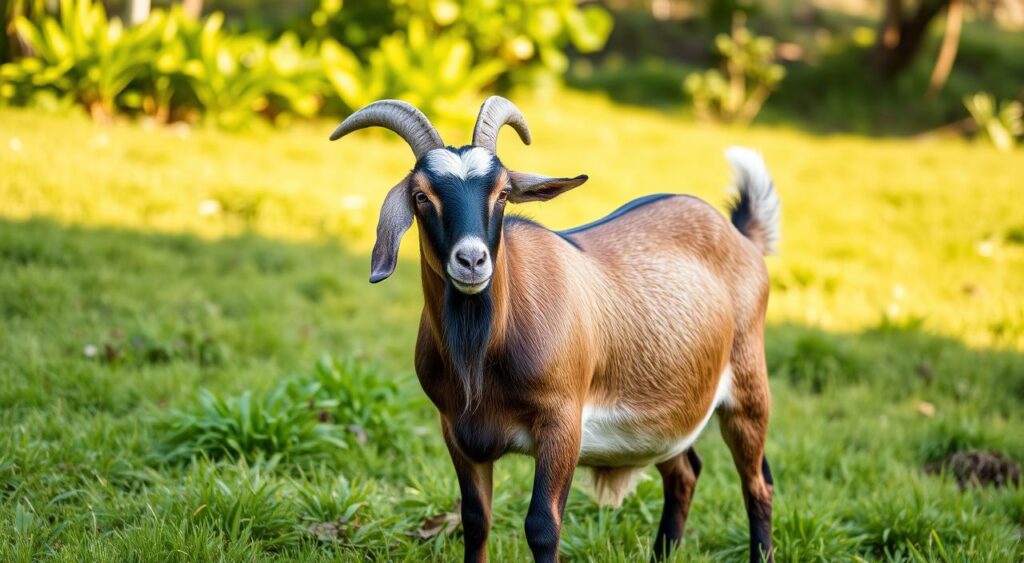
The Osmanabadi goat breed comes from the Osmanabad region of Maharashtra, India. It’s known for its amazing milking skills. These goats are medium-sized and have black or brown coats. They are famous for their high reproductive rates and twinning percentages.
Exceptional Milk Production
Osmanabadi goats can produce up to 3.5 kg of milk a day. Their lactation period is about 4 months. This makes them a top choice for commercial goat farming.
Their milk is not only abundant but also very nutritious. It has more butterfat and protein than other goat breeds in India. This is great for making cheese, yogurt, and ice cream.
| Milk Yield Characteristics | Osmanabadi Goats |
|---|---|
| Average Daily Milk Yield | 0.5 to 1.5 kg |
| Lactation Period | Approximately 4 months |
| Milk Composition | Higher butterfat and protein content |
The Osmanabadi goat is a top pick for farmers in India. It’s hardy, disease-resistant, and adaptable to different climates and feeds. This makes it perfect for commercial goat farming.
Changthangi Goat Breed
In the high-altitude regions of Ladakh, India, the Changthangi goat breed is a natural wonder. These small, hardy goats are famous for their top-quality pashmina fiber. Their coat colors range from white to black, making them well-suited for the cold Himalayan climate.
The Changthangi goats are a treasure for the local Changpa nomadic communities. They provide milk, meat, and income, keeping people financially stable. This has been true for generations.
Pashmina Fiber Production: A Valuable Asset
The Changthangi goat’s greatest asset is its ability to produce the finest pashmina fiber. This fiber, with a thickness of 12 to 15 microns, is used to make famous Kashmir Pashmina shawls. It’s harvested once a year, showing the breed’s amazing ability to thrive in Ladakh’s harsh environment.
Compared to other goats, the Changthangi’s pashmina fiber is unmatched. Farmers in this region make a lot of money from it. They earn up to Rs 970.96 per animal, with pashmina and value-added products making up a big part of their profits.
Despite its great value, the Changthangi goat faces big challenges. The breed’s numbers are going down, and its productivity is limited. It’s important to save and promote this unique breed. This will help keep the pashmina industry alive and support the Changpa communities.
Surti Goat Breed
The Surti goat is a remarkable dairy goat breed found mainly in Surat, Gujarat, India. It’s known for its high milk production and is perfect for farming. This breed is recognized as one of the top dairy goats in the country.
High Milk Yield
Surti goats are famous for their impressive milk yield. A healthy Surti doe can produce 2.0 to 2.25 liters of milk per day when fed in stalls. Even when grazing, they yield about 1.2 kilograms of milk daily. This high milk production makes them a great choice for dairy farming.
These goats are also known for their exceptional reproductive abilities. They reach breeding age between 400 to 500 days and often have multiple offspring. This makes them valuable in crossbreeding programs to improve other goat breeds.
Despite being considered endangered, the Surti goat is a popular choice among farmers. They are hardy, adaptable, and suitable for both milk and meat production.
If you’re a seasoned goat farmer or new to the industry, the Surti goat is worth exploring. Its high milk yield, prolific breeding, and adaptability to various climates make it a standout choice for dairy and meat farming in India.
Sangamneri Goat Breed
The Sangamneri goat breed is a key player in the rural economy of Maharashtra, India. It comes from Nasik, Ahmednagar, and Pune districts. These goats are famous for their meat.
Sangamneri goats stand out with their white coats and black and brown spots. Both males and females have horns that curve backward. Some even have beards or wattles. Adult bucks weigh 39 to 42 kg, and does weigh 32 to 34 kg.
These goats are not just good for meat. They also produce a lot of milk. In 160 days, they can give 0.5 to 1 kilogram of milk daily. This makes them very useful for farmers.
For Sangamneri goats to grow well, they need good housing, food, and health care. They do best in clean, airy places. They eat fresh greens, dry roughage, and minerals. Regular shots and deworming keep them healthy.
The Sangamneri goat breed is a great choice for farmers in Maharashtra. It meets the growing demand for quality meat and milk. By using these goats, farmers can make the most of the goat farming industry.
Bengal Goat Breed
The Bengal goat is a standout among India’s goat breeds for its high fertility. It comes from West Bengal and is known for having many kids at once. This makes it a great choice for farmers wanting to grow their herd fast.
Multiple Births: A Boon for Goat Farmers
Bengal goats are famous for their ability to have twins, triplets, or even quadruplets. This is a big plus for farmers. It helps them quickly grow their herd and boost their income from meat and milk.
Studies show Bengal goats have a kidding rate of 150-180%. This means for every 100 female goats, they can have 150-180 baby goats. Such high fertility means farmers can count on a steady income from their goats.
| Goat Breed | Average Kidding Rate | Typical Litter Size |
|---|---|---|
| Bengal Goat | 150-180% | 2-4 kids |
| Jamunapari Goat | 120-140% | 1-2 kids |
| Sirohi Goat | 140-160% | 2-3 kids |
| Barbari Goat | 160-180% | 2-3 kids |
The Bengal goat’s high fertility and adaptability make it very popular among farmers in India. By using this breed, farmers can increase their herd’s productivity. This helps the goat farming industry grow in the country.
Sirohi Goat Breed
The Sirohi goat comes from the Sirohi district of Rajasthan, India. They are medium to large in size. Their coats range from light to dark brown with black markings on the neck and head.
Adult male Sirohi goats weigh about 50 kg. Female Sirohi goats weigh around 23 kg.
Sirohi goats are known for their high milk production. They produce 1.5 to 2.5 liters of milk daily. They also have impressive growth rates, with males gaining 87.52g and females gaining 51.35g daily.
Female Sirohi goats are 65.83 cm long, 66.79 cm around the chest, and 71.61 cm tall. This makes them a sturdy and compact breed.
The Sirohi goat population has grown significantly. In 1972, there were 295,000 goats. By 2013, the number had jumped to 1.82–3.08 million, as reported to DAD-IS. The FAO and DAD-IS have not listed this breed as at risk.

